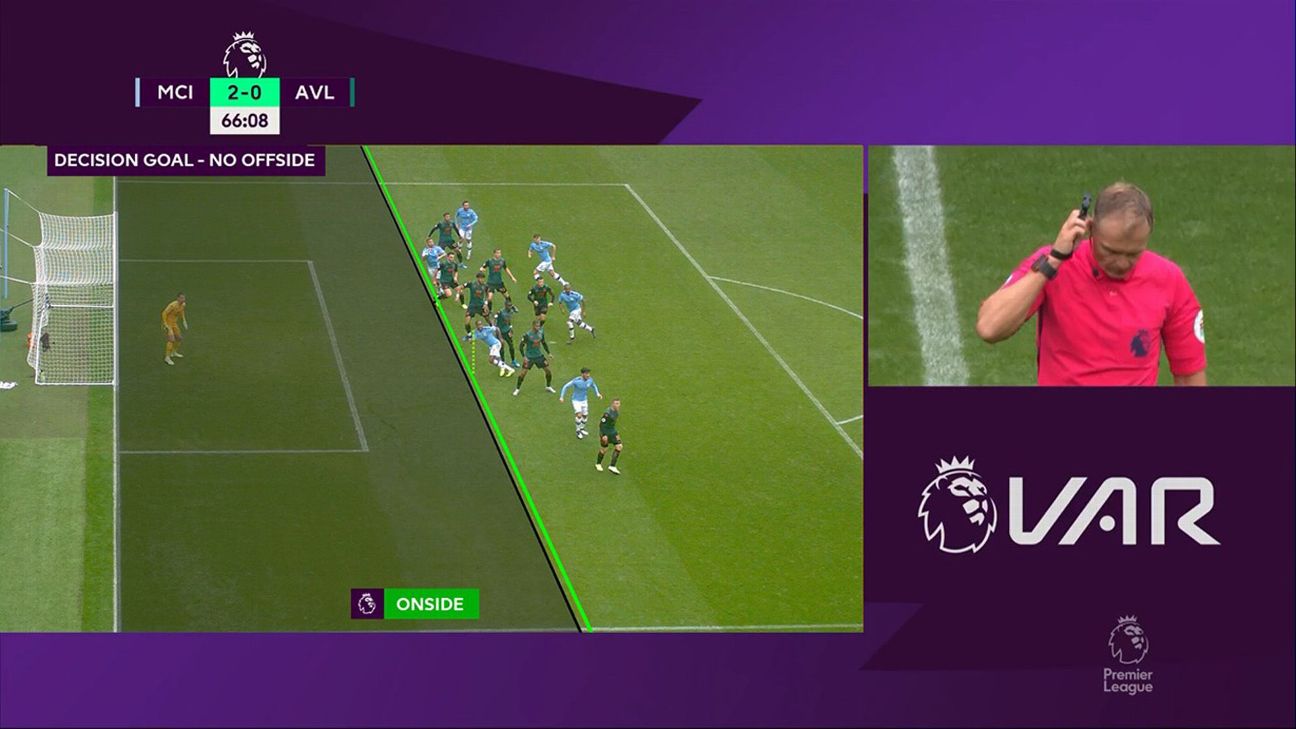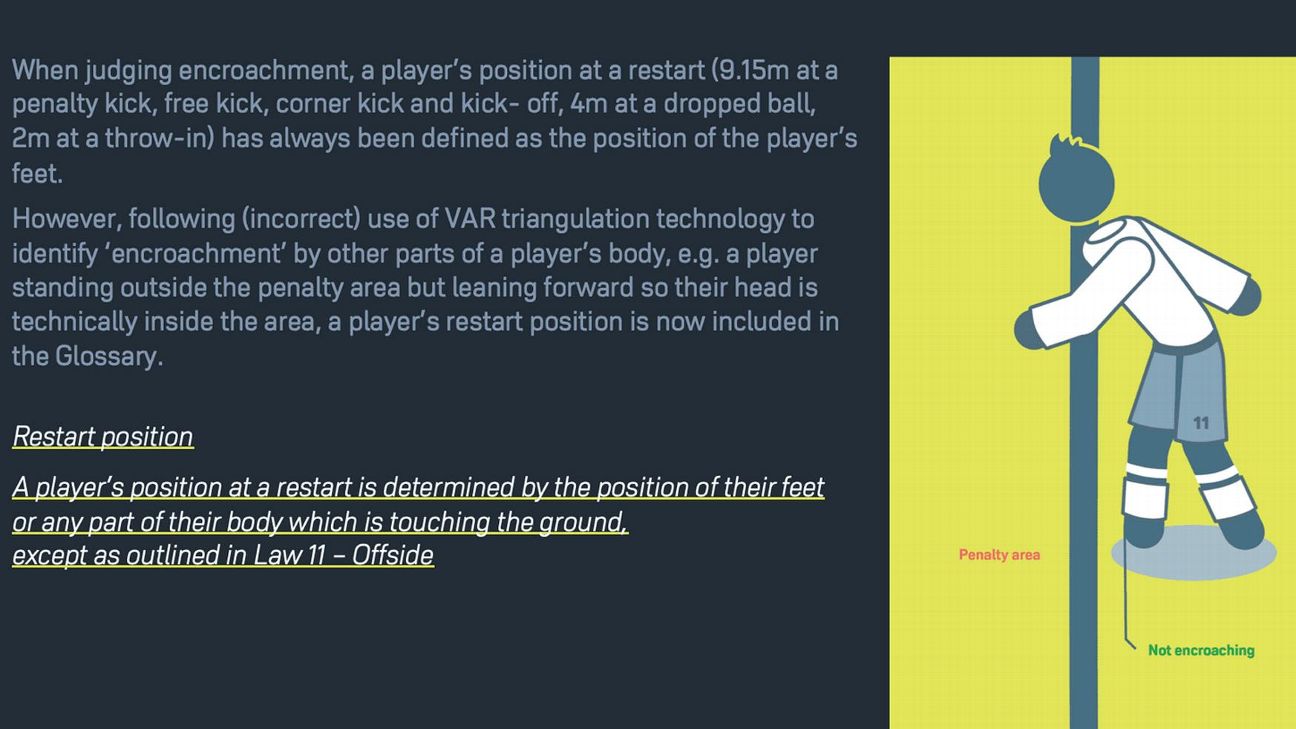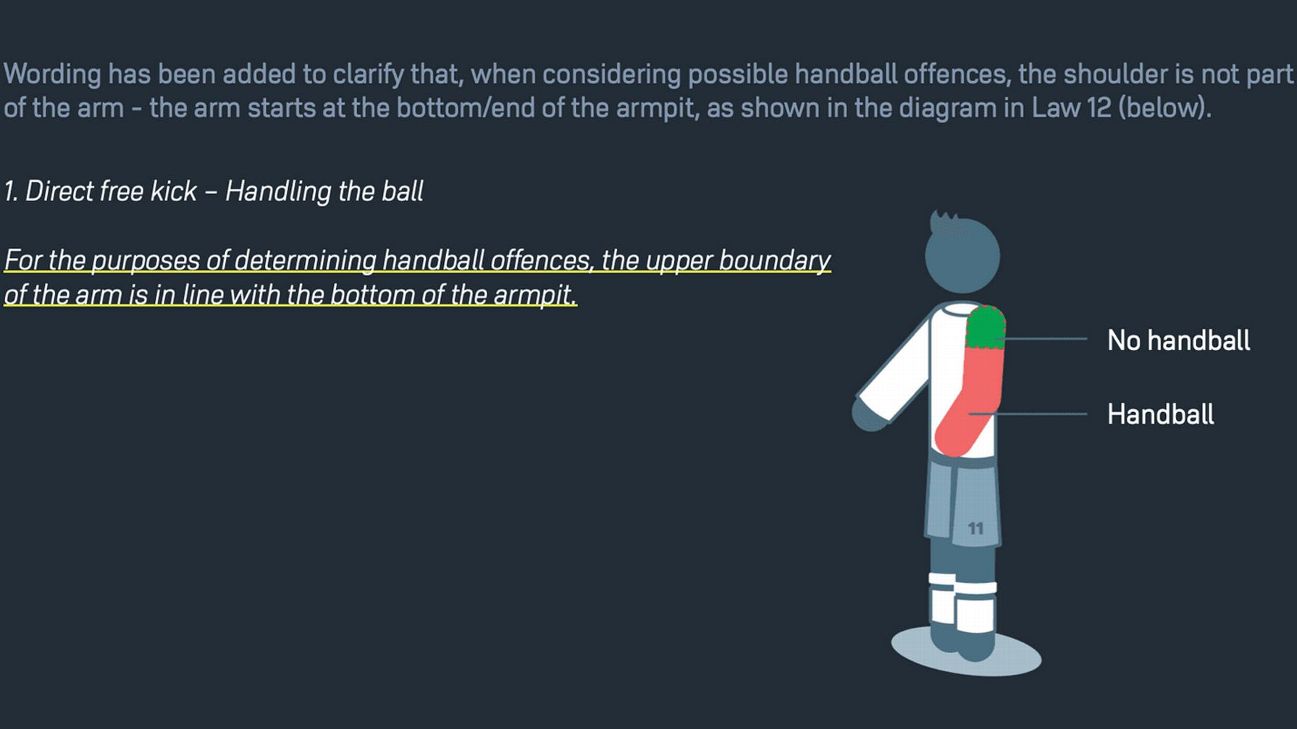Whether you like it or not, VAR is back for the 2020-21 Premier League season. But has it changed for the better?
JUMP TO: Pitchside monitors | Offside decisions | Flagging for offside | Encroachment on penalties | Goal-line technology fix | The handball offence | Defensive handball | Attacking handball
Remember that crunching tackle from Tottenham Hotspur midfielder Giovani Lo Celso on Chelsea's Cesar Azpilicueta? An obvious red card that the VAR said was just fine? Increased use of those pitchside monitors should make it easier to avoid such errors.
What about all those goals that were disallowed for handball by an attacker? We're thinking Lucas Moura inadvertently playing the ball through for Harry Kane to score for Spurs. Or Declan Rice controlling the ball with his arm before setting up a goal for West Ham United. Well, we might have solved some of those. But not all, because the Aymeric Laporte handball before Gabriel Jesus scored for Manchester City against Spurs is held up by the lawmakers as an shining example of good decision-making.
What about players stood statuesque waiting for offside to be given after the flag has been raised? Think of Manchester United's and David De Gea with his arm aloft as Pierre-Emerick Aubameyang netted for Arsenal. And Jonjo Shelvey waltzing through the Sheffield United defence as it stared in disbelief at the referee and referee's assistant. Well the referee's assistants might just keep the flag down from now on.
Remember the penalty Manchester United conceded against Bournemouth for handball by Eric Bailly? A reworking of the handball law wouldn't see that given.
- VAR in the Premier League - all your questions answered
And who could forget those "toenail" and "armpit" offside decisions? Teemu Pukki for Norwich City against Spurs, Son Heung-Min against Leicester City and Sheff United's John Lundstram, also against Spurs? Well, we're not going to be able to fix everything in one summer.
Expect penalties retaken after a goalkeeper has moved just an inch off the line, while a stricter defensive handball interpretation is likely to see far more spot kicks awarded. Remember the ball hitting the arm of Liverpool's Trent Alexander-Arnold against Man City?
Let's just say VAR is going to continue to dominate the discussion for a while yet.
VAR
Why will it be different this season?
First and foremost, FIFA has taken overall control of the VAR project globally, which was being jointly overseen by football's lawmakers, the IFAB. The Premier League, which operated its own interpretation of several elements of VAR last season, has agreed to fall in line and follow the official protocol.
So what has changed and how will it affect games?
- Don't have ESPN? Get instant access
- Predict results in ESPN's English Soccer Pick 'Em!
Pitchside monitor use
FIFA calls this the Referee Review Area, the TV at the side of the pitch used to watch a replay of subjective decisions, like possible penalties and red cards. It will not be used for factual decisions such as offside. Last season, the monitor was only used as a confirmatory process for a handful of red-card decisions from January onwards, and had little impact.
What difference will it make? It is without doubt a good thing. It will give much greater accountability to the match referee, and should at least bring greater understanding that a decision has been reviewed. Last season, all the responsibility lay with the VAR, who would have to make a judgement on the match referee's interpretation of an incident. Now, the match referee will make the call. Some fear this may make reviews last longer, that seems unlikely but only experience will tell us. If this helps prevents howlers like the missed red card for Lo Celso on Azpilicueta, then it has to be a good thing.
Will it fix anything? VAR is far from perfect in other leagues, so this is by no means a magic wand. It doesn't remove the initial layer of judgement, whereby the VAR still needs to decide that a clear and obvious error has been made and advise the match referee to use the monitor. Therefore, fans will need to understand that we won't see every contentious decision being sent to the monitor. There may be a period of adjustment, but hopefully we will avoid the situation whereby obvious red cards and penalties were not being awarded because the VAR was unsure what the match referee had actually seen. Remember, though, that the mere fact they are subjective decisions means it's impossible we'll agree every time.
Offside decisions
Unfortunately, very little has changed. Reports that the Premier League would try to implement a "level of tolerance" to marginal offsides proved to be incorrect, with FIFA insisting that there can be no margin for error applied. If technology shows a player is offside (or of course onside), even by a few millimetres, the VAR must give the appropriate decision.
FIFA and the IFAB are exploring ways to revamp the offside law but trials, the key first step, have not yet been approved so the law will remain as it is now until, at the very earliest, the 2022-23 season.
Deciding which VAR images will be shown still sits with the TV broadcasters, so if you are wondering why you haven't seen a replay that's not down to the VAR.
The confusing "crosshair" calculation process, when lines are drawn on the screen, is still here. However, there has been a tweak to the final image to make it clearer to supporters, using the "traffic light" system. If a player is offside the line and the graphic will be red, while an onside decision produces green graphics.


What difference will it make? As the VAR offside process itself can be very confusing, and few accept the very marginal decisions, then the use of a green line is unlikely to help. The Premier League wanted to offer some leniency, but FIFA has said the law must be applied to the letter. Therefore, there will be very little difference this season. We are still left with the frustrating, marginal decisions -- like Teemu Pukki for Norwich City against Spurs -- and the delay while the VAR draws the offside lines.
Will it fix anything? Absolutely not, the rows over offside are here to stay.
Flagging for offside
Last season, the Premier League went against official VAR protocol and instructed referee's assistants to raise their flags on all offside decisions, and then leave it to the referee to stop the game. Now, when there is an immediate goal-scoring opportunity, the referee's assistant will keep the flag down and only raise it at the end of the attacking phase -- whether that come via a goal or perhaps the ball going out of play for a corner to the attacking team.
What difference will it make? It was undoubtedly confusing to defenders when a flag was raised and play continued. Players were told to "play to the whistle," but sometimes instinct would take over. Most famously, Newcastle United scored at Sheffield United when the referee's assistants raised the flag, but the referee allowed the move to complete as defenders stood with arms aloft while goalkeeper Dean Henderson barely attempted a save. This season, this referee's assistant would not raise the flag and would wait until the attacker, Jonjo Shelvey, scored -- thus not distracting the defending team.
Will it fix anything? It is without doubt the better system, even if sometimes a flag not going up immediately may frustrate. The old system confused referee's assistants as much as anyone else last season, but now the protocol should be easier to understand for all. It also opens the opportunity for a defending team to essentially play "advantage" and start a counterattack if they break up play and move up field quickly, without the need to stop for the free kick.
Encroachment on penalties
Last season, the Premier League, the Bundesliga and UEFA chose not to enforce a goalkeeper moving off the line on penalty kicks through the VAR. But now the VAR will make sure the goalkeeper has part of one foot level with the goal-line. The goalkeeper is warned for the first offence and is then shown a yellow card for any further offence. Bookings in the course of a match do not carry through to a possible penalty shootout, so a goalkeeper booked once in the match and once in the shootout would not be sent off.
In addition, the IFAB made a law clarification that encroachment by attackers and defenders will only be judged by the part of the body touching the ground, so almost always the feet, rather than how they may lean into the box.

What difference will it make? We are certain to see penalties retaken where a goalkeeper has marginally moved off the line, often caused by a striker feinting in running to the ball. It's worth noting this only applies when the goalkeeper has made a save, so not when the ball hits the woodwork or misses the target. For outfield players, the difference may be negligible and the greater controversy could come from the VAR deciding if a player's forward foot is touching the ground or not. All of the penalties retaken for a defensive infringement last season would still be an offence.
Will it fix anything? Other than the law being applied to the letter, this probably isn't a positive change because there really wasn't anything wrong with how the law was applied prior to the change in the summer of 2019. However, at least it does bring consistency with both offside and goalkeeper encroachment being enforced to the smallest of margins.
Goal-line technology fix
Some people argued that Aston Villa only stayed in the Premier League by virtue of the point they picked up at home to Sheffield United, when goal-line technology failed and robbed the Blades of a goal in a game that finished 0-0. Villa stayed up on goal difference.
Hawk-Eye, the operators of the Goal Decision System, blamed "a level of occlusion" that had never been seen before in over 9,000 matches. The good news is it should never happen again, as the system now has an alert built in to warn of a "possible occlusion event."
Laws of the Game
As well as changes to VAR, the IFAB has also tweaked a number of laws which will impact upon games with and without VAR this season -- some more than others.
The handball offence
Believe it or not, before this summer the Laws of the Game never specified where a handball offence should start and stop on the arm. But fear not! This has all been cleared up with a diagram to show what is, and isn't, handball. Unfortunately, this won't exactly end the rows, as it's still going to be subjective about where exactly the ball hits.

The IFAB has described this area as the T-shirt line. Except, it's not what you think -- and this is going to lead to confusion. The T-shirt line is not the bottom of the sleeve, because of course teams have different lengths of sleeve and players also play in long-sleeved shirts. It's defined as the top of the shoulder area down to the where it meets the armpit. Got it?
What difference will it make? It will definitely mean there are fewer goals ruled out for attacking handball. For instance, Leander Dendoncker's goal for Wolves at Leicester after the ball hit the top of Willy Boly's arm would count. Remember Bournemouth having a Harry Wilson goal ruled out and a penalty awarded to Burnley for a handball by Adam Smith earlier in the move? That Wilson goal would now stand. And the penalty that Manchester United conceded against Bournemouth for handball by Eric Bailly would not be given this season.
Will it fix anything? It will fix some things, but certainly not everything. Reducing the number of disallowed goals (the VAR chalked off 56 in the Premier League last season, 14 of them for handball) is key if VAR is to be accepted. But we are still going to be arguing about this, just to a lesser degree. The key thing is that most supporters didn't realise the new "no handball" area was actually being interpreted as handball before this summer. That means fans should now get more decisions which they expect, which is definitely an improvement.
However, a knock-on effect is that the attacker's body is now extended for offside decisions. So while this fixes part of the problem, it's created a new one. Additional goals will disallowed when a player is running or leaning with the arm extended.
Defensive handball
This is not a change in the law, more the Premier League having to refine its definition to fall in line with FIFA. Very few penalties were awarded for defensive handball last season, with Premier League referees being lenient. Handball decisions in the Europe and other major leagues have been far stricter.
What difference will it make? We are almost certain to see many more penalties. There were eight awarded for handball by the VAR in the Premier League last season while, comparatively over the same number of games, there were 14 in the Bundesliga. And that doesn't take into account spot kicks awarded directly by the match referee. Remember the ball hitting the arm of Liverpool's Trent Alexander-Arnold against Man City? This season that might well be a penalty kick.
Will it fix anything? It may be a case of be careful what you wish for, though we wait to see just how strictly PGMOL applies this defensive handball law. A more uniform interpretation removes some of the subjectivity and creates more consistency. But will it be better than what we had before?
Attacking handball
Apart from perhaps offside, this caused the most controversy last season. Fourteen goals were chalked off by the VAR for handball last season, but this part of the law has only been tweaked to make it clear there must be immediacy between the attacking handball and the goal. That means the player must set up the goal, or score it, straight away. The best way to think of this is it has to happen around the penalty area, and that handball must set up the goal-scoring chance for the player or a team-mate straight away. So handball, dribble and pass will not be penalised.
What difference will it make? Believe it or not, the Premier League got the interpretation of attacking handball law pretty much spot on last season. However, the Laws of the Game never stipulated in enough detail when, and where on the pitch, attacking handball should be penalised. Now, for the most part, everyone should have a better idea of how the law should be applied.
Will it fix anything? Robert Snodgrass saw a late equaliser for West Ham United at Sheffield United ruled out by the VAR for handball in the build up by Declan Rice. That goal would now stand as Rice moved up the field before creating the goal for Snodgrass. However, the Harry Kane goal for Tottenham Hotspur at Sheffield United, chalked off for handball by Lucas Moura as he was fouled, would most likely still be disallowed as it directly created the scoring chance.
However, the IFAB holds up the Gabriel Jesus disallowed goal against Spurs, following for a feather-touch handball by Aymeric Laporte, as an example of how the law should be applied. So while this interpretation will be better, don't think for one minute it is going to fix attacking handball. There will still be many goals ruled out this season, some of them down to the opinion of the VAR, but we could see the number halved.
Other notable changes
Five subs: Premier League clubs (twice) voted against keeping five substitutes, as used during Project Restart. The Big Six clubs, plus Brighton & Hove Albion, were its biggest supporters but it couldn't garner the necessary 14 votes to pass a rule change.
Drinks breaks: Or tactical breaks, as they came to be known. These have essentially been abolished, as they will only be used if the temperature is above 30 degrees Celsius (86 degrees Fahrenheit).
Yellow cards: Players will now be booked for not retreating on a dropped ball; a goalkeeper can receive a yellow for touching the ball a second time after a restart (goal kick, free kick)
Holding: A definition of this offence has been added for the first time, to say it occurs when "a player's contact with an opponent's body or equipment impedes the opponent's movement." It is unclear if this will have any impact on referees clamping down on grappling in the box.
